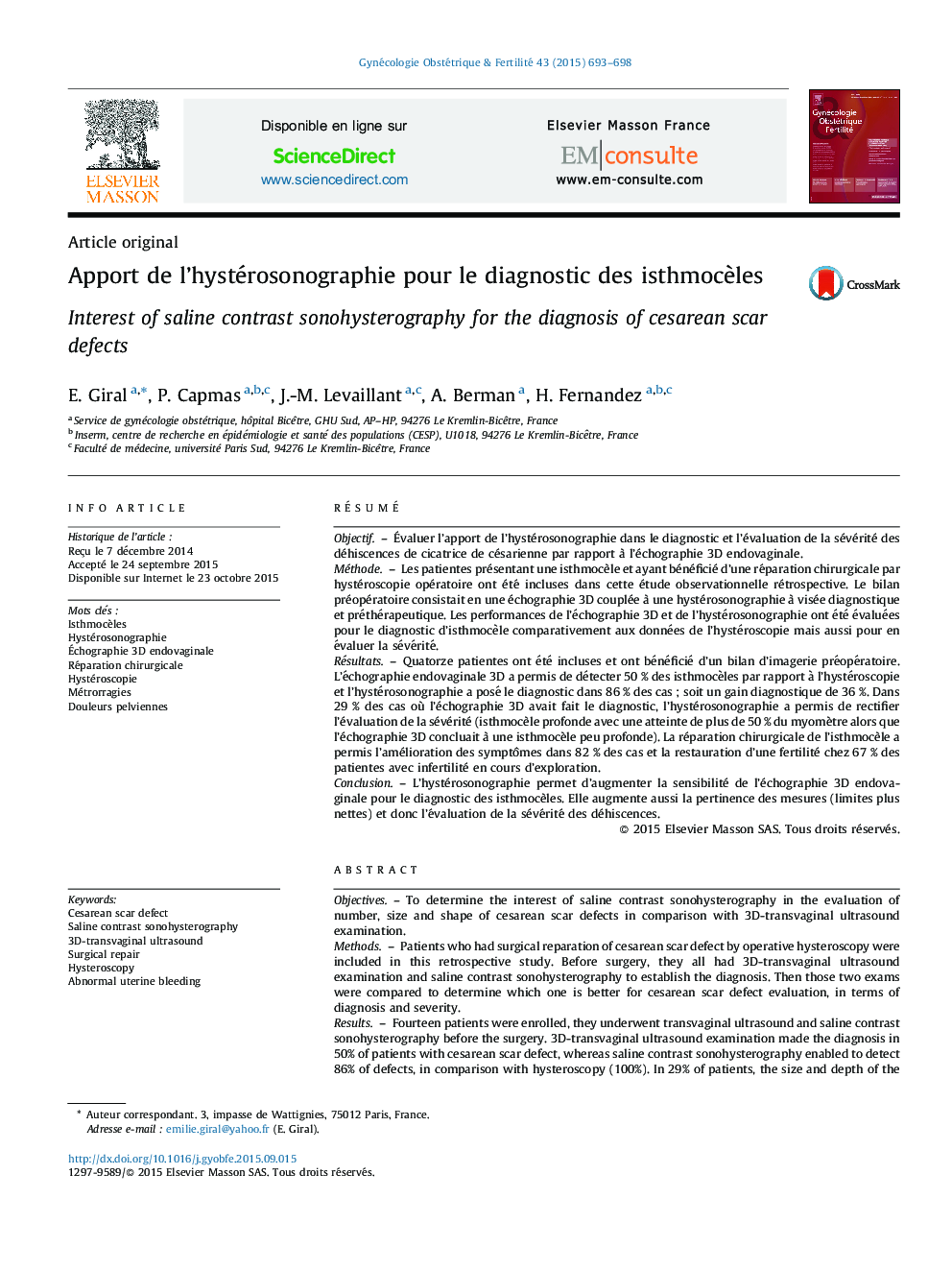| کد مقاله | کد نشریه | سال انتشار | مقاله انگلیسی | نسخه تمام متن |
|---|---|---|---|---|
| 3951285 | 1254854 | 2015 | 6 صفحه PDF | دانلود رایگان |

RésuméObjectifÉvaluer l’apport de l’hystérosonographie dans le diagnostic et l’évaluation de la sévérité des déhiscences de cicatrice de césarienne par rapport à l’échographie 3D endovaginale.MéthodeLes patientes présentant une isthmocèle et ayant bénéficié d’une réparation chirurgicale par hystéroscopie opératoire ont été incluses dans cette étude observationnelle rétrospective. Le bilan préopératoire consistait en une échographie 3D couplée à une hystérosonographie à visée diagnostique et préthérapeutique. Les performances de l’échographie 3D et de l’hystérosonographie ont été évaluées pour le diagnostic d’isthmocèle comparativement aux données de l’hystéroscopie mais aussi pour en évaluer la sévérité.RésultatsQuatorze patientes ont été incluses et ont bénéficié d’un bilan d’imagerie préopératoire. L’échographie endovaginale 3D a permis de détecter 50 % des isthmocèles par rapport à l’hystéroscopie et l’hystérosonographie a posé le diagnostic dans 86 % des cas ; soit un gain diagnostique de 36 %. Dans 29 % des cas où l’échographie 3D avait fait le diagnostic, l’hystérosonographie a permis de rectifier l’évaluation de la sévérité (isthmocèle profonde avec une atteinte de plus de 50 % du myomètre alors que l’échographie 3D concluait à une isthmocèle peu profonde). La réparation chirurgicale de l’isthmocèle a permis l’amélioration des symptômes dans 82 % des cas et la restauration d’une fertilité chez 67 % des patientes avec infertilité en cours d’exploration.ConclusionL’hystérosonographie permet d’augmenter la sensibilité de l’échographie 3D endovaginale pour le diagnostic des isthmocèles. Elle augmente aussi la pertinence des mesures (limites plus nettes) et donc l’évaluation de la sévérité des déhiscences.
ObjectivesTo determine the interest of saline contrast sonohysterography in the evaluation of number, size and shape of cesarean scar defects in comparison with 3D-transvaginal ultrasound examination.MethodsPatients who had surgical reparation of cesarean scar defect by operative hysteroscopy were included in this retrospective study. Before surgery, they all had 3D-transvaginal ultrasound examination and saline contrast sonohysterography to establish the diagnosis. Then those two exams were compared to determine which one is better for cesarean scar defect evaluation, in terms of diagnosis and severity.ResultsFourteen patients were enrolled, they underwent transvaginal ultrasound and saline contrast sonohysterography before the surgery. 3D-transvaginal ultrasound examination made the diagnosis in 50% of patients with cesarean scar defect, whereas saline contrast sonohysterography enabled to detect 86% of defects, in comparison with hysteroscopy (100%). In 29% of patients, the size and depth of the cesarean scar defect was more important with saline contrast sonohysterography and hysteroscopy than expected by 3D-transvaginal ultrasound examination. After surgical repair, symptoms improvement was found in 82% of case (pain or abnormal uterine bleeding), and fertility was restored in 67%.ConclusionSaline contrast sonohysterography is better to characterize cesarean scar defects than 3D-transvaginal ultrasound, with a higher sensibility. Moreover, it evaluates more precisely the size and shape of the defect, thus severity.
Journal: Gynécologie Obstétrique & Fertilité - Volume 43, Issue 11, November 2015, Pages 693–698